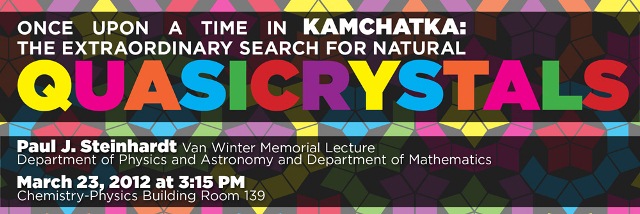
By Sarah Geegan
Paul Steinhardt, professor of physics and astrophysical sciences at Princeton University, will deliver the Van Winter Memorial Lecture at the University of Kentucky from 3:15-4:15 p.m. Friday, March 23, in Room 139 of the Chemistry-Physics Building.
The Van Winter Memorial Lecture honors Clasine Van Winter, a professor in the UK departments of Mathematics and Physics and Astronomy from 1968-1999. Van Winter is best known for Weinberg-Van Winter equations for multi-particle quantum systems.
The annual lecture brings distinguished physicists or mathematicians to UK to discuss topics of common interest between the two disciplines.
The lecture, "Once Upon a Time in Kamchatka: the Extraordinary Search for Natural Quasicrystals," will focus on the significance of these substances in both mathematics and physics.
Steinhardt is the Albert Einstein Professor in Science at Princeton University, a professorship endowed in the name of Einstein with a grant from the International Business Machines Corporation. Steinhardt is also the director of the Princeton Center for Theoretical Science.
His research extends across studies in particle physics, cosmology, astrophysics and condensed matter physics.
The lecture will focus on quasicrystals — a type of structure that shows rotational symmetry, but does not have a pattern that repeats over a distance.
In the 1980s chemists found that they could make materials that did not conform to established notions of what crystals can be like. Steinhardt and physicist Dov Levine showed that these materials were in fact structures that mathematicians earlier considered as theoretical possibilities. These structures had unique properties and deserved to be classified as new phases of matter. They called them "quasicrystals."
Steinhardt will discuss this development as well as the technological applications of quasicrystals in his lecture.
Physics and astronomy Professor Sumit Das coordinated this year's lecture. Das said that Steinhardt's experience as a broad physicist, who is not confined to narrow areas of specialization, means students across multiple disciplines will appreciate his insight.
"Steinhardt's research spans over a wide area of theoretical physics," Das said. "There are two areas which would be of particular interest to UK students. The first is cosmology. Steinhardt is one of the key architects of the theory of inflation, which argues that our universe underwent a period of rapidly accelerated expansion at early times, very soon after the big bang."
Das said that this explains many of the puzzling aspects of the large scale structure of the universe and has nearly become a paradigm for understanding the early universe. Steinhardt and collaborators explored an interesting alternative to inflation called, "ekpyrotic universe."
"The second area of interest to UK students is quasicrystals," Das said. "The chemist Dan Shechtman, who first experimentally made quasicrystals in the laboratory, received the Nobel Prize in Chemistry last year. Recently, Steinhardt led a geological expedition which discovered the first naturally occurring quasicrystal, as opposed to quasicrystals fabricated in the lab."
Das said that eminent lecturers, such as Steinhardt, not only provide food for thought for the university's researchers, but also inspire students by exposing the excitement of academic pursuit.
"UK is committed to excellence in both undergraduate education and graduate research," Das said. "Bringing in dignified lecturers plays a key role in fulfilling this commitment."
For more information on the lecture, or to listen to a podcast, produced by the College of Arts and Sciences, in which Das discusses the lecture, click here.
